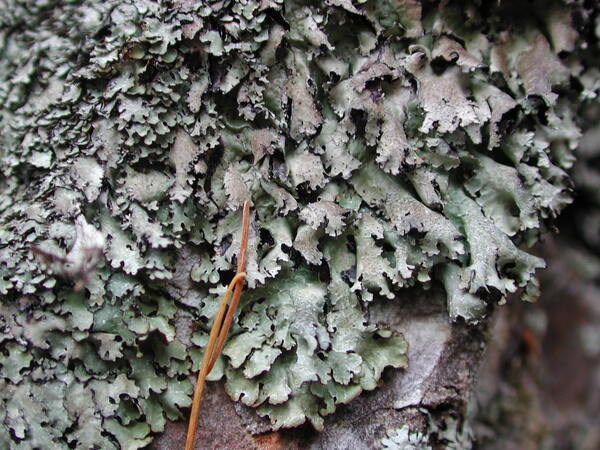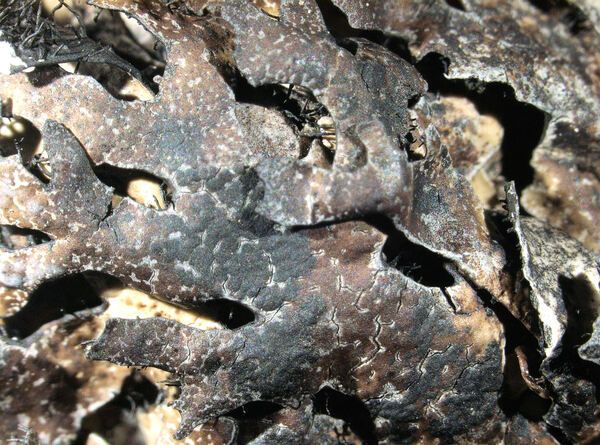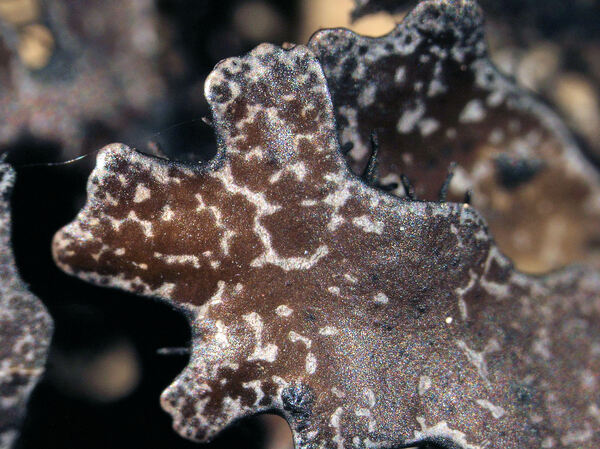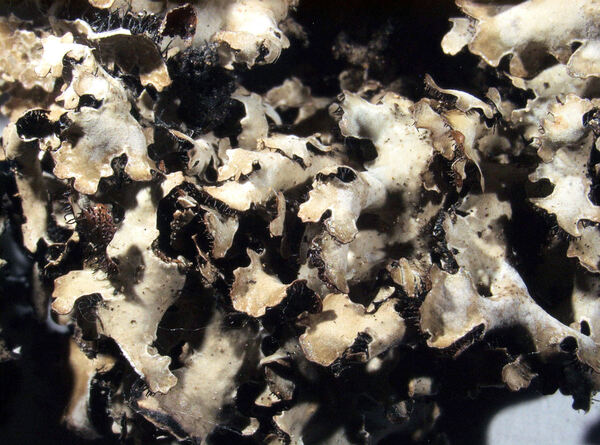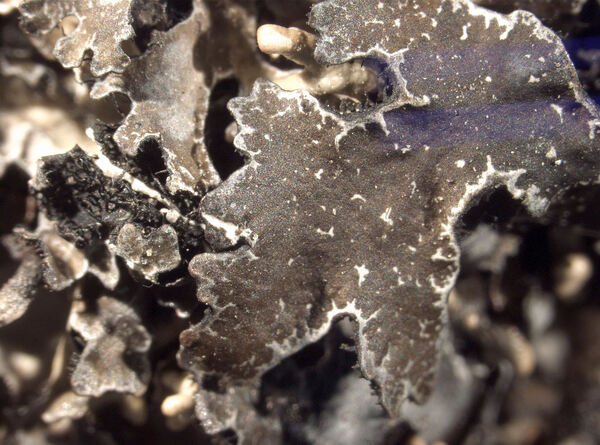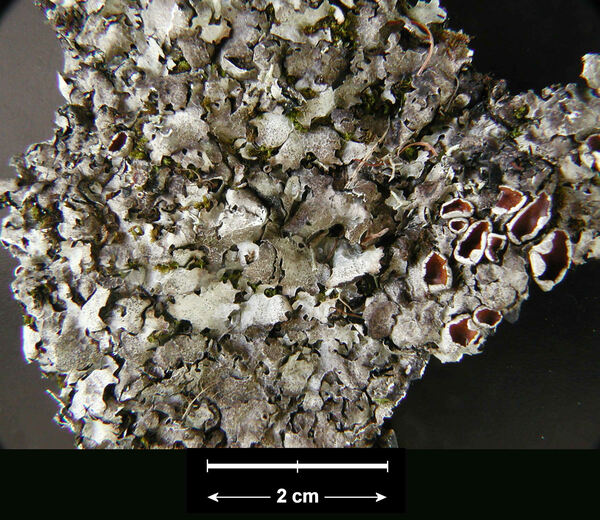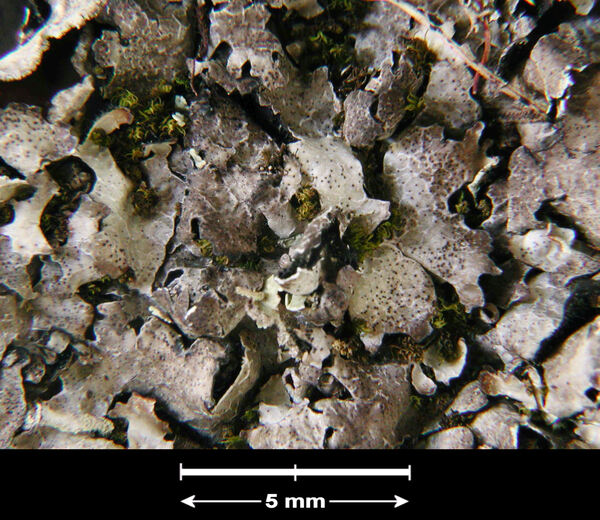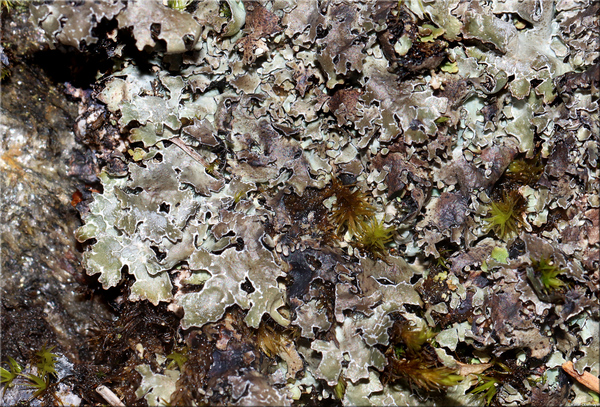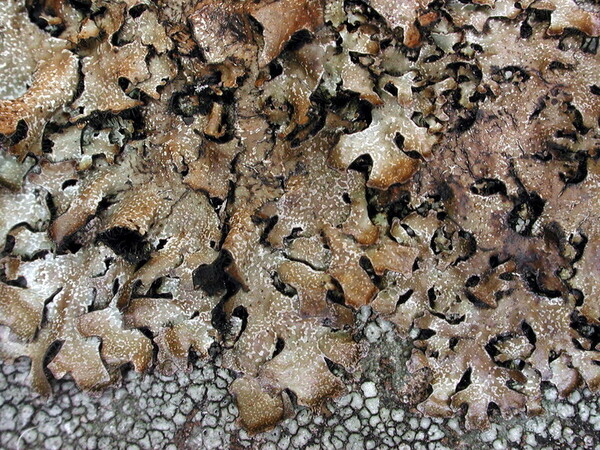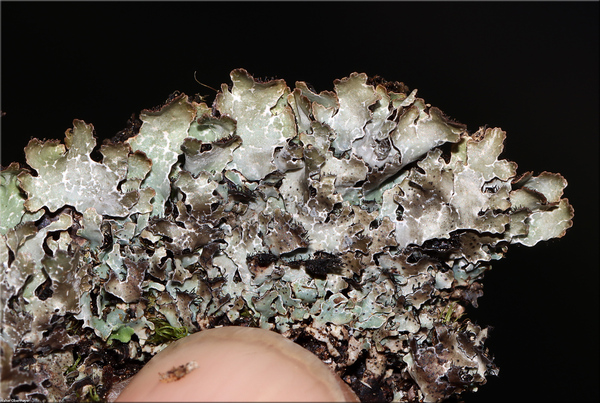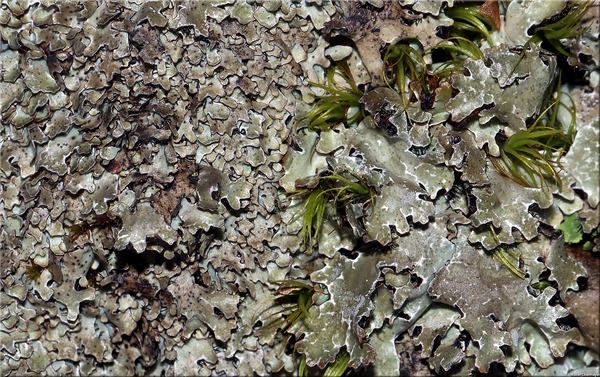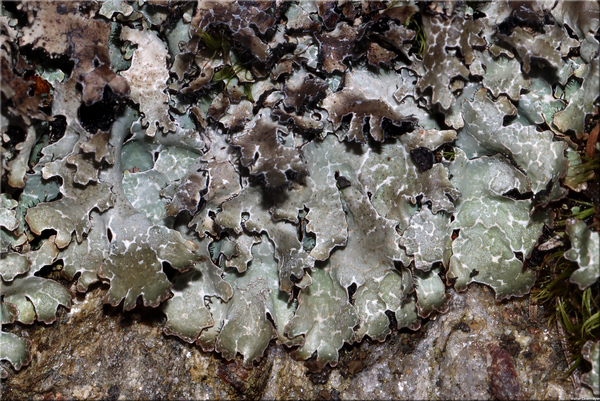Parmelia omphalodes (L.) Ach.
Meth. Lich.: 204, 1803. Basionym: Lichen omphalodes L. - Sp. Pl.: 1143, 1753.
Synonyms: Imbricaria saxatilis var. omphalodes (L.) Körb.; Parmelia insensitiva Anders; Parmelia saxatilis var. omphalodes (L.) Fr.
Description: Thallus foliose, heteromerous, dorsiventral, rather loosely attached, forming more or less regular, up to 15 cm wide rosettes which often merge into extensive swards. Lobes 2-4(-5) mm wide, with angular apices, often imbricate. Upper surface of variable colour, from pale grey in shade-forms to brown, dark brown or almost black in sun-forms, slightly shiny, epruinose, with a conspicuous network of laminal and marginal, whitish, at first punctiform but soon linear pseudocyphellae; lower surface black, with simple or forked, black rhizines most abundant towards the margin. Upper cortex paraplectenchymatous, of 2-6 layers of densely packed cells, with a usually non-pored epicortex, the cell walls with isolichenan; medulla white; algal layer continuous; lower cortex paraplectenchymatous, thinner than upper cortex. Apothecia rare, lecanorine, cup-shaped, to 12 mm across, with a dark brown, often splitting disc and a prominent thalline margin. Epithecium brownish; hymenium and hypothecium colourless. Asci 8-spored, clavate, Lecanora-type. Ascospores 1-celled, hyaline, ellipsoid, 10-15 x 7-9 µm. Pycnidia common, black, laminal. Conidia more or less thickened at both ends, 5.5-6.5 x c. 1 µm. Photobiont chlorococcoid. Spot tests: upper cortex K+ yellow (but often slowly turning dirty red due to medullary substances), C-, KC-, P- or P+ faintly yellow; medulla K+ yellow turning dirty red, C-, KC-, P+ orange-red. Chemistry: upper cortex with atranorin; medulla with consalazinic and salazinic acids (major), and variable amounts of lobaric, galbinic, protolichesterinic and fumarprotocetraric acids.
Growth form: Foliose, broad lobed
Substrata: rocks
Photobiont: green algae other than Trentepohlia
Reproductive strategy: mainly asexual, by thallus fragmentation
Commonnes-rarity: (info)
Alpine belt: rather common
Subalpine belt: very common
Montane belt: extremely rare
Dry submediterranean belt: absent
Humid submediterranean belt: absent
Padanian area: absent
pH of the substrata:
1 2 3 4 5
Solar irradiation:
1 2 3 4 5
Aridity:
1 2 3 4 5
Eutrophication:
1 2 3 4 5
Poleotolerance:
0 1 2 3
Altitudinal distribution:
1 2 3 4 5 6
Rarity
absent
extremely rare
very rare
rare
rather rare
rather common
common
very common
extremely common
Loading data...
Occurrence data
Predictive map

Michel David - Source: http://www.lichensmaritimes.org/index.php?task=fiche&lichen=207&lang=en
France, Toulinguet
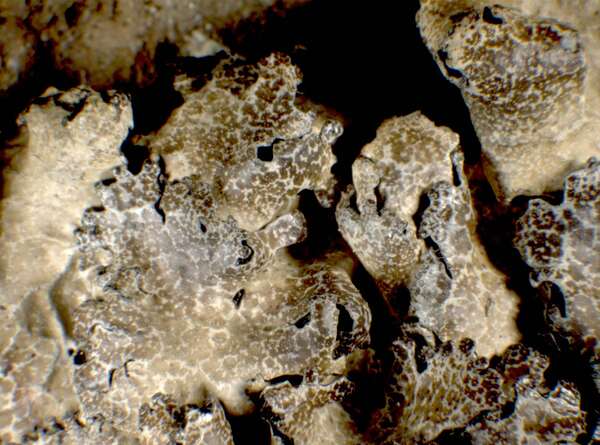
P.L. Nimis; Owner: Department of Life Sciences, University of Trieste
Herbarium: TSB (9675)
2001/12/05
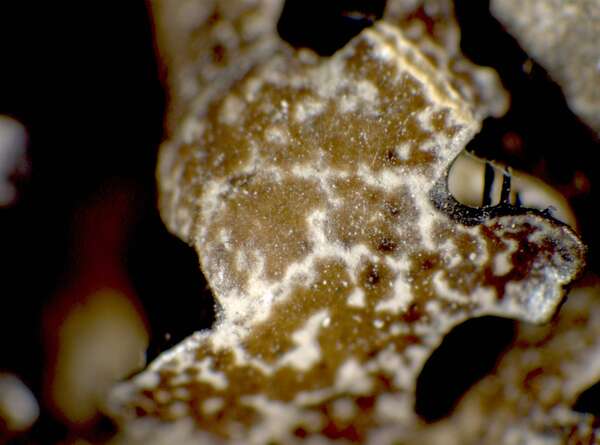
P.L. Nimis; Owner: Department of Life Sciences, University of Trieste
Herbarium: TSB (9675)
2001/12/05
detail of pseudocyphellae
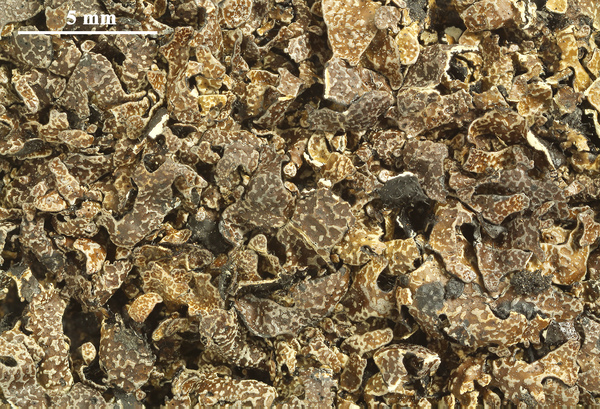
Felix Schumm - CC BY-SA 4.0
[0329], Gallia, Finistère, Pointe de Pen-Hir, ad scopulos prope litum. Annot: Lobaric acid, salazinic acid, consalazinic acid and trace of galbinic acid by TLC, A. Johnson and C. F. Culberson (no 2746).Leg. W.L. Culberson (10483) & C.F. Culberson. A. VEZDA: LICHENES SELECTI EXSICCATI NR. 1740
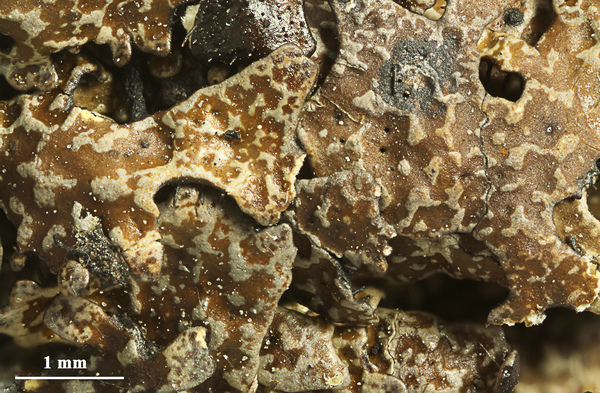
Felix Schumm - CC BY-SA 4.0
[0329], Gallia, Finistère, Pointe de Pen-Hir, ad scopulos prope litum. Annot: Lobaric acid, salazinic acid, consalazinic acid and trace of galbinic acid by TLC, A. Johnson and C. F. Culberson (no 2746).Leg. W.L. Culberson (10483) & C.F. Culberson. A. VEZDA: LICHENES SELECTI EXSICCATI NR. 1740
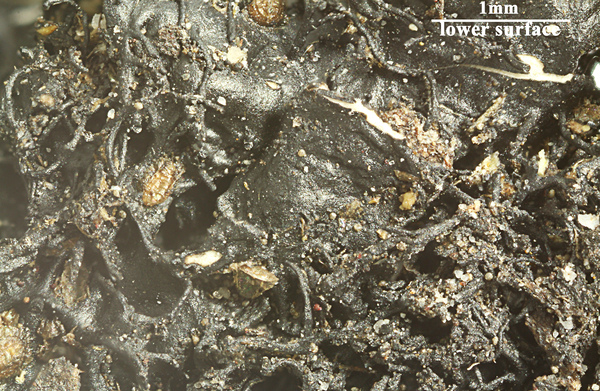
Felix Schumm - CC BY-SA 4.0
[0329], Gallia, Finistère, Pointe de Pen-Hir, ad scopulos prope litum. Annot: Lobaric acid, salazinic acid, consalazinic acid and trace of galbinic acid by TLC, A. Johnson and C. F. Culberson (no 2746).Leg. W.L. Culberson (10483) & C.F. Culberson. A. VEZDA: LICHENES SELECTI EXSICCATI NR. 1740
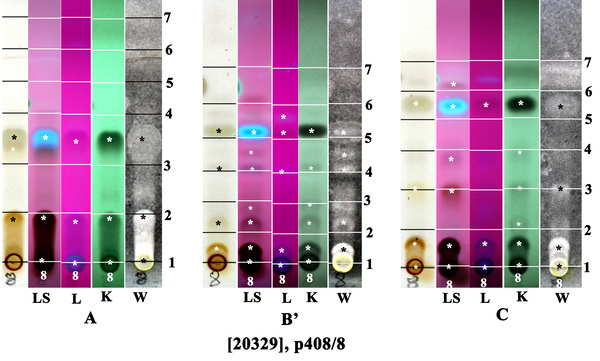
Felix Schumm - CC BY-SA 4.0
[0329], Gallia, Finistère, Pointe de Pen-Hir, ad scopulos prope litum. Annot: Lobaric acid, salazinic acid, consalazinic acid and trace of galbinic acid by TLC, A. Johnson and C. F. Culberson (no 2746).Leg. W.L. Culberson (10483) & C.F. Culberson. A. VEZDA: LICHENES SELECTI EXSICCATI NR. 1740
L: lobaric acid, s: salazinic acid, cs: consalazinic acid, a,b: unkown
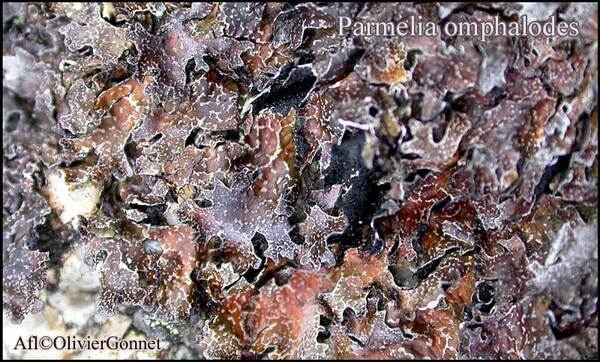
Courtesy Danièle et Olivier Gonnet - Source: https://www.afl-lichenologie.fr/Photos_AFL/Photos_AFL_P/Parmelia_omphalodes.htm
France, sur rocher siliceux - session AFL 2005 - Lozère
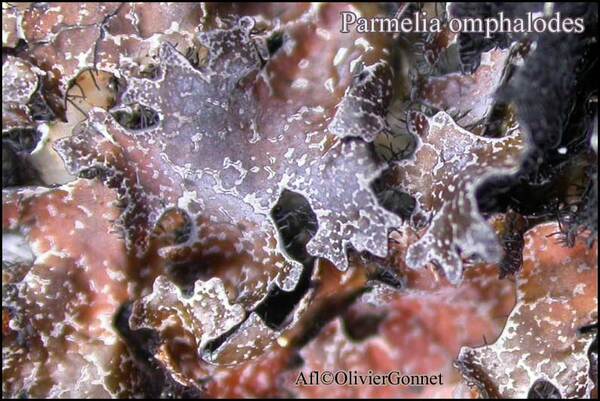
Courtesy Danièle et Olivier Gonnet - Source: https://www.afl-lichenologie.fr/Photos_AFL/Photos_AFL_P/Parmelia_omphalodes.htm
France, sur rocher siliceux - session AFL 2005 - Lozère
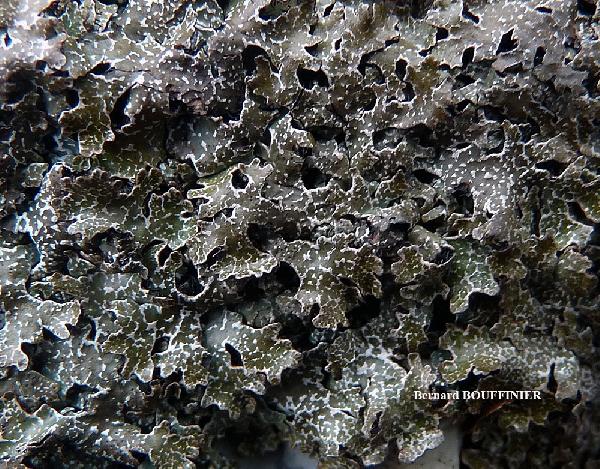
Bernard Bouffinier - Source: http://www.lichensmaritimes.org/index.php?task=fiche&lichen=207&lang=en
France, Kador
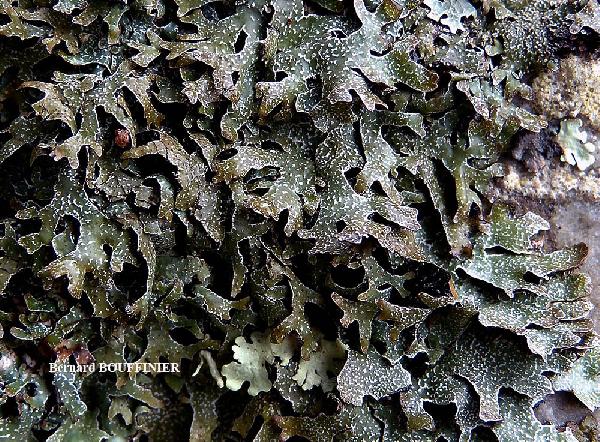
Bernard Bouffinier - Source: http://www.lichensmaritimes.org/index.php?task=fiche&lichen=207&lang=en
France, Kador
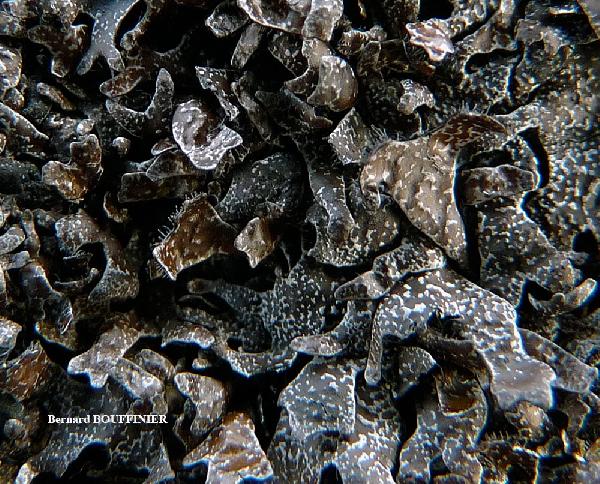
Bernard Bouffinier - Source: http://www.lichensmaritimes.org/index.php?task=fiche&lichen=207&lang=en
France, Pointe de Dinan
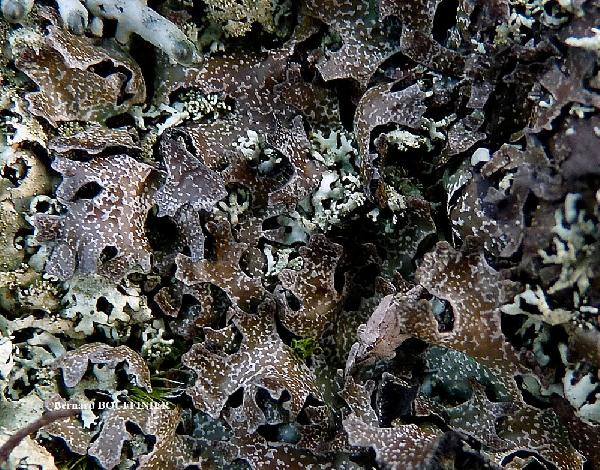
Bernard Bouffinier - Source: http://www.lichensmaritimes.org/index.php?task=fiche&lichen=207&lang=en
France, Pointe du Guern
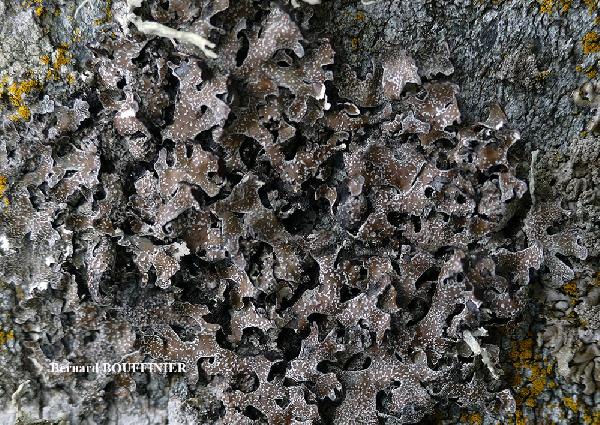
Bernard Bouffinier - Source: http://www.lichensmaritimes.org/index.php?task=fiche&lichen=207&lang=en
France, Roc'h Trevezel

Bernard Bouffinier - Source: http://www.lichensmaritimes.org/index.php?task=fiche&lichen=207&lang=en
France, Roc'h Trevezel

Bernard Bouffinier - Source: http://www.lichensmaritimes.org/index.php?task=fiche&lichen=207&lang=en
France, Pointe de Pen-Hir
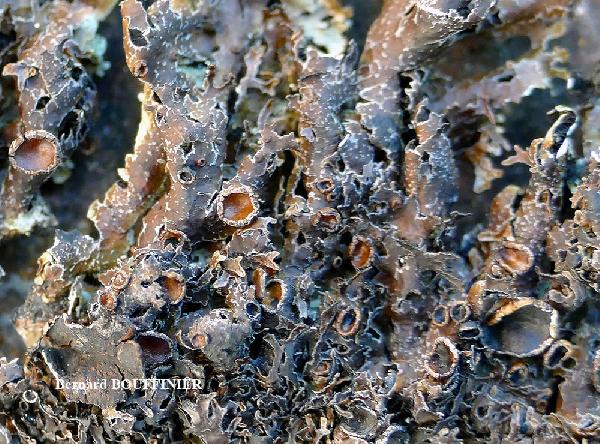
Bernard Bouffinier - Source: http://www.lichensmaritimes.org/index.php?task=fiche&lichen=207&lang=en
France, Cap de la Chèvre
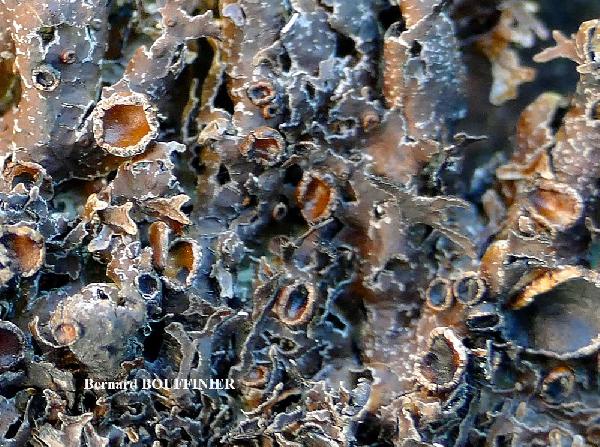
Bernard Bouffinier - Source: http://www.lichensmaritimes.org/index.php?task=fiche&lichen=207&lang=en
France, Cap de la Chèvre
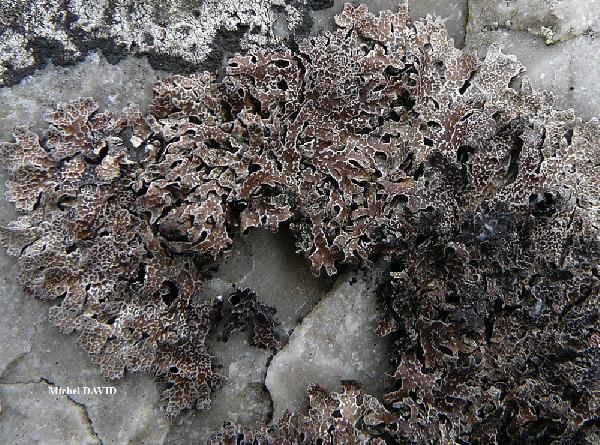
Michel David - Source: http://www.lichensmaritimes.org/index.php?task=fiche&lichen=207&lang=en
France, Tavelle
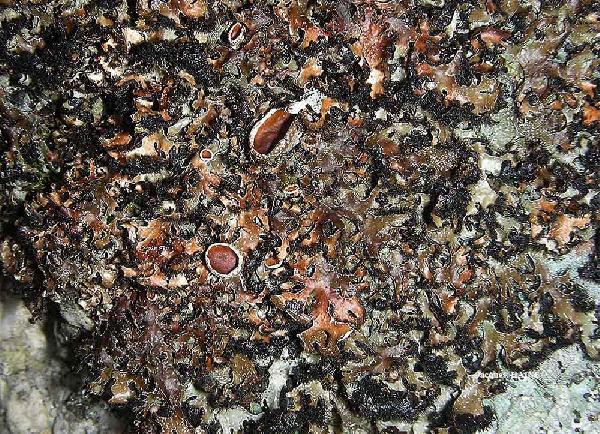
Michel David - Source: http://www.lichensmaritimes.org/index.php?task=fiche&lichen=207&lang=en
Belgium, Monthermé
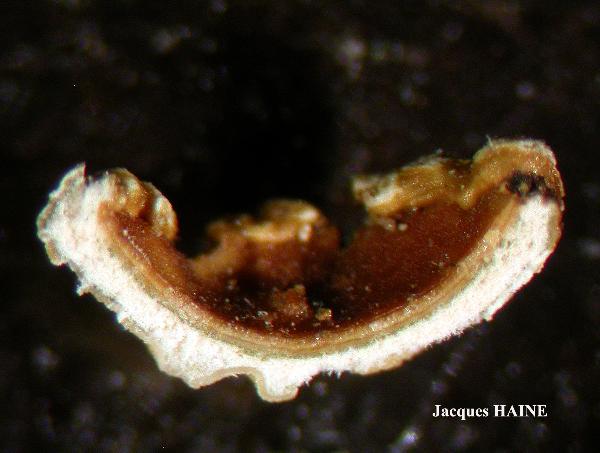
Michel David - Source: http://www.lichensmaritimes.org/index.php?task=fiche&lichen=207&lang=en
Belgium, Monthermé
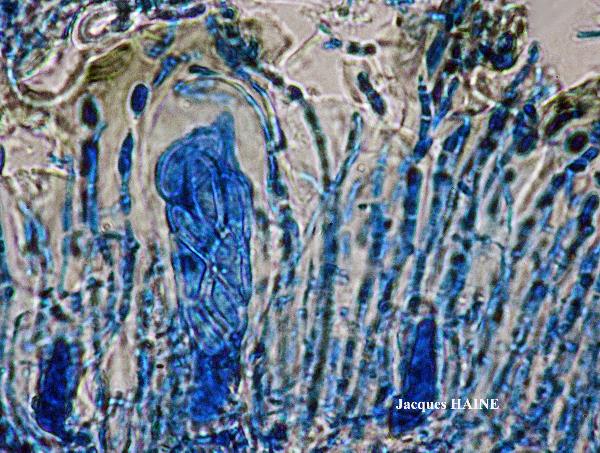
Michel David - Source: http://www.lichensmaritimes.org/index.php?task=fiche&lichen=207&lang=en
Belgium, Monthermé
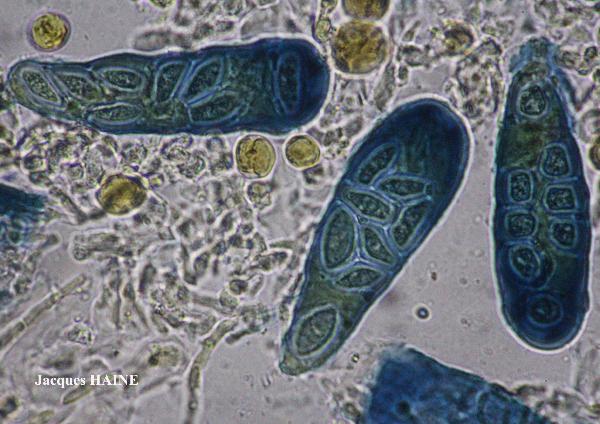
Michel David - Source: http://www.lichensmaritimes.org/index.php?task=fiche&lichen=207&lang=en
Belgium, Monthermé
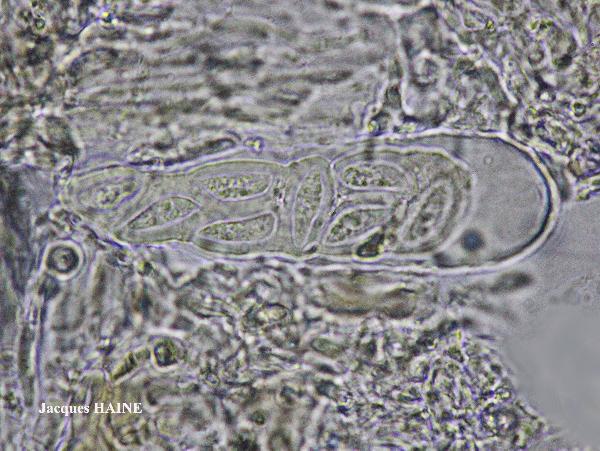
Michel David - Source: http://www.lichensmaritimes.org/index.php?task=fiche&lichen=207&lang=en
Belgium, Monthermé
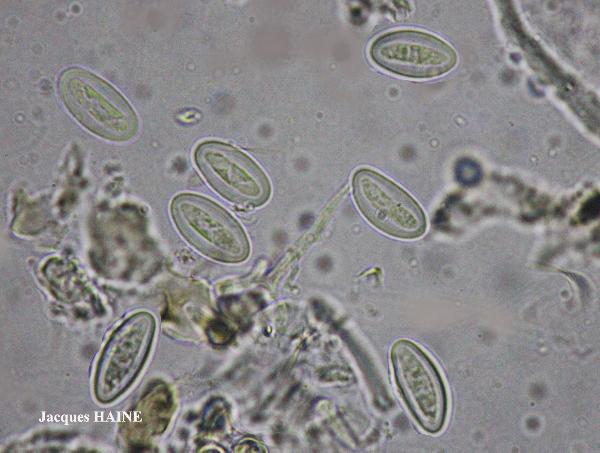
Michel David - Source: http://www.lichensmaritimes.org/index.php?task=fiche&lichen=207&lang=en
Belgium, Monthermé
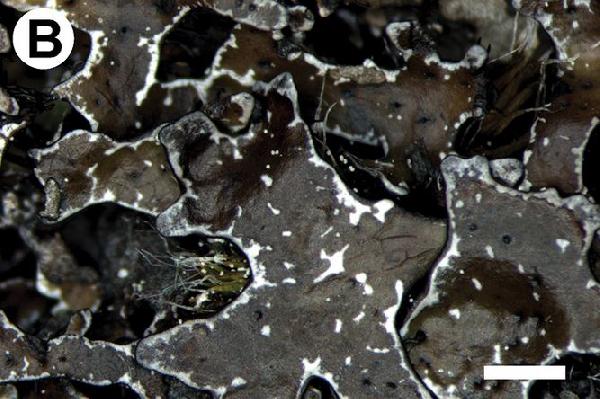
Source:Ossowska E, Guzow-Krzemińska B, Kolanowska M, Szczepańska K, Kukwa M (2019) Morphology and secondary chemistry in species recognition of Parmelia omphalodes group – evidence from molecular data with notes on the ecological niche modelling and genetic variability of photobionts. MycoKeys 61: 39-74. - CC BY-4.0
B P. omphalodes, with marginal and laminal pseudocyphellae, laminal pseudocyphellae mostly not connected with marginal ones (S F-252845) C P. pinnatifida, with marginal pseudocyphellae (UGDA L-24298)
Growth form: Foliose, broad lobed
Substrata: rocks
Photobiont: green algae other than Trentepohlia
Reproductive strategy: mainly asexual, by thallus fragmentation
Commonnes-rarity: (info)
Alpine belt: rather common
Subalpine belt: very common
Montane belt: extremely rare
Dry submediterranean belt: absent
Humid submediterranean belt: absent
Padanian area: absent
pH of the substrata:
| 1 | 2 | 3 | 4 | 5 |
Solar irradiation:
| 1 | 2 | 3 | 4 | 5 |
Aridity:
| 1 | 2 | 3 | 4 | 5 |
Eutrophication:
| 1 | 2 | 3 | 4 | 5 |
Poleotolerance:
| 0 | 1 | 2 | 3 |
Altitudinal distribution:
| 1 | 2 | 3 | 4 | 5 | 6 |
Rarity
absent
extremely rare
very rare
rare
rather rare
rather common
common
very common
extremely common
Loading data...
Occurrence data
Predictive map

Michel David - Source: http://www.lichensmaritimes.org/index.php?task=fiche&lichen=207&lang=en
France, Toulinguet

P.L. Nimis; Owner: Department of Life Sciences, University of Trieste
Herbarium: TSB (9675)
2001/12/05

P.L. Nimis; Owner: Department of Life Sciences, University of Trieste
Herbarium: TSB (9675)
2001/12/05
detail of pseudocyphellae

Felix Schumm - CC BY-SA 4.0
[0329], Gallia, Finistère, Pointe de Pen-Hir, ad scopulos prope litum. Annot: Lobaric acid, salazinic acid, consalazinic acid and trace of galbinic acid by TLC, A. Johnson and C. F. Culberson (no 2746).Leg. W.L. Culberson (10483) & C.F. Culberson. A. VEZDA: LICHENES SELECTI EXSICCATI NR. 1740

Felix Schumm - CC BY-SA 4.0
[0329], Gallia, Finistère, Pointe de Pen-Hir, ad scopulos prope litum. Annot: Lobaric acid, salazinic acid, consalazinic acid and trace of galbinic acid by TLC, A. Johnson and C. F. Culberson (no 2746).Leg. W.L. Culberson (10483) & C.F. Culberson. A. VEZDA: LICHENES SELECTI EXSICCATI NR. 1740

Felix Schumm - CC BY-SA 4.0
[0329], Gallia, Finistère, Pointe de Pen-Hir, ad scopulos prope litum. Annot: Lobaric acid, salazinic acid, consalazinic acid and trace of galbinic acid by TLC, A. Johnson and C. F. Culberson (no 2746).Leg. W.L. Culberson (10483) & C.F. Culberson. A. VEZDA: LICHENES SELECTI EXSICCATI NR. 1740

Felix Schumm - CC BY-SA 4.0
[0329], Gallia, Finistère, Pointe de Pen-Hir, ad scopulos prope litum. Annot: Lobaric acid, salazinic acid, consalazinic acid and trace of galbinic acid by TLC, A. Johnson and C. F. Culberson (no 2746).Leg. W.L. Culberson (10483) & C.F. Culberson. A. VEZDA: LICHENES SELECTI EXSICCATI NR. 1740
L: lobaric acid, s: salazinic acid, cs: consalazinic acid, a,b: unkown

Courtesy Danièle et Olivier Gonnet - Source: https://www.afl-lichenologie.fr/Photos_AFL/Photos_AFL_P/Parmelia_omphalodes.htm
France, sur rocher siliceux - session AFL 2005 - Lozère

Courtesy Danièle et Olivier Gonnet - Source: https://www.afl-lichenologie.fr/Photos_AFL/Photos_AFL_P/Parmelia_omphalodes.htm
France, sur rocher siliceux - session AFL 2005 - Lozère

Bernard Bouffinier - Source: http://www.lichensmaritimes.org/index.php?task=fiche&lichen=207&lang=en
France, Kador

Bernard Bouffinier - Source: http://www.lichensmaritimes.org/index.php?task=fiche&lichen=207&lang=en
France, Kador

Bernard Bouffinier - Source: http://www.lichensmaritimes.org/index.php?task=fiche&lichen=207&lang=en
France, Pointe de Dinan

Bernard Bouffinier - Source: http://www.lichensmaritimes.org/index.php?task=fiche&lichen=207&lang=en
France, Pointe du Guern

Bernard Bouffinier - Source: http://www.lichensmaritimes.org/index.php?task=fiche&lichen=207&lang=en
France, Roc'h Trevezel

Bernard Bouffinier - Source: http://www.lichensmaritimes.org/index.php?task=fiche&lichen=207&lang=en
France, Roc'h Trevezel

Bernard Bouffinier - Source: http://www.lichensmaritimes.org/index.php?task=fiche&lichen=207&lang=en
France, Pointe de Pen-Hir

Bernard Bouffinier - Source: http://www.lichensmaritimes.org/index.php?task=fiche&lichen=207&lang=en
France, Cap de la Chèvre

Bernard Bouffinier - Source: http://www.lichensmaritimes.org/index.php?task=fiche&lichen=207&lang=en
France, Cap de la Chèvre

Michel David - Source: http://www.lichensmaritimes.org/index.php?task=fiche&lichen=207&lang=en
France, Tavelle

Michel David - Source: http://www.lichensmaritimes.org/index.php?task=fiche&lichen=207&lang=en
Belgium, Monthermé

Michel David - Source: http://www.lichensmaritimes.org/index.php?task=fiche&lichen=207&lang=en
Belgium, Monthermé

Michel David - Source: http://www.lichensmaritimes.org/index.php?task=fiche&lichen=207&lang=en
Belgium, Monthermé

Michel David - Source: http://www.lichensmaritimes.org/index.php?task=fiche&lichen=207&lang=en
Belgium, Monthermé

Michel David - Source: http://www.lichensmaritimes.org/index.php?task=fiche&lichen=207&lang=en
Belgium, Monthermé

Michel David - Source: http://www.lichensmaritimes.org/index.php?task=fiche&lichen=207&lang=en
Belgium, Monthermé




